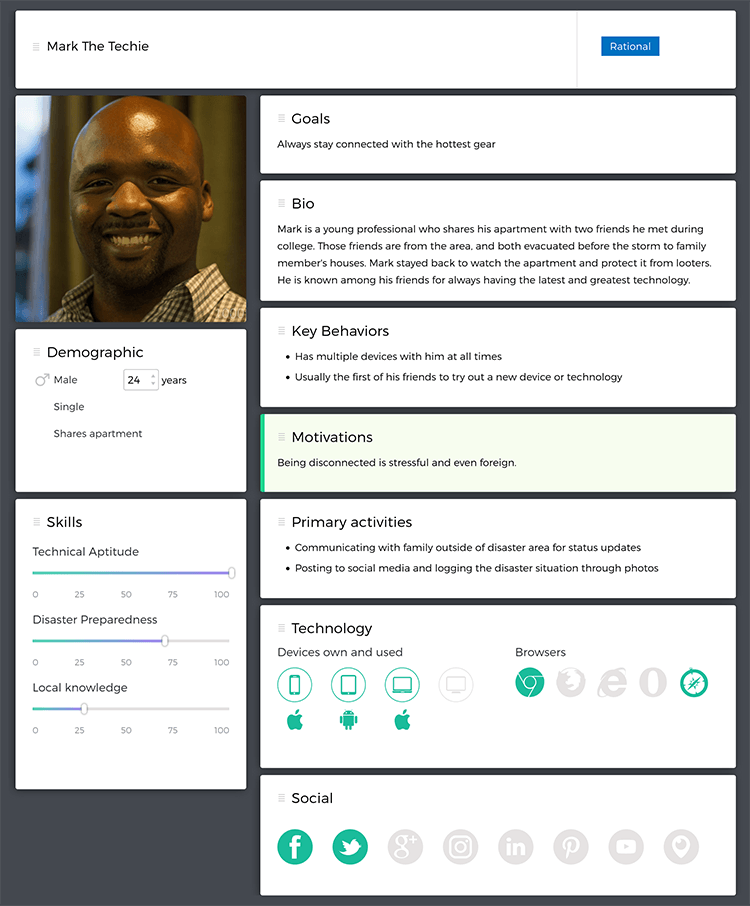Okay, we’ve spent considerable time telling you how to create personas and what benefits they can bring to your company. This time we’ll talk about what traits make personas good or bad. And it’s not about temper. It’s about whether a given persona fulfills its purpose or not. Whether it benefits your design process or drags it all the way down to the dark cold bottom. So what are the traits that your personas must have in order to be most beneficial? Let’s find it out together with UXPressia!
When you first start with personas nothing seems complicated. It’s like back in our childhood when we would make up perfect imaginary friends. But the childhood’s over. No unicorns and ponies anymore. Making personas is much more complicated. Thankfully, it’ll get easier once you’re hooked up with the following tips. So without any further ado, let’s see what makes a good persona.
Matching Reality

Photo: http://fieldtrip.laartlab.org
The first key to creating good helpful personas is ensuring that they reflect the reality. It might seem obvious, but often teams decide to build personas based on hypothesis neglecting fact-check. In most of such cases, it results in misleading teams and derailing whole projects. Gigantic time losses with redesigning everything from the ground up is the best that can happen in the end. The worst scenario is if they lose customers and financing.
Notice, however, that there is absolutely nothing wrong if personas come from assumptions. Sometimes it’s the only way. For instance, if you use personas to design a product from scratch. The real evil, though, comes from forgetting to check how close to reality your assumptions are. Surely, we can find cases where personas built on assumptions were way more effective than those built on studies. But we’ll all agree that those are exceptions, not rules. So don't take your chances.
Understanding Customers
Another kind-of-obvious-but-often-forgotten trait - good personas help you understand the customer. Your personas must describe customers the best way possible. They cannot be just made up stories with faces and names. They must reflect every tiny detail about the target group they represent.
Here’s how you can tell if a persona is sound. When you look at it, you should see clear answers to questions like:
- Who is your customer?
- What are their goals?
- What’s their behavior?
- What motivates and what frustrates them?
- What pain points and challenges do they have?
- What does their typical day look like?
If you can answer all these questions by looking at your persona, good news – you made it right!
And to help you keep it organized and pretty, UXPressia offers you the ultimate tool for making personas. Over 20 sections to put your answers in and truly see who your customers are. Check out this persona made with UXPressia:

With it, there’s no way some tiny detail slips away from you!
Describing a subgroup

The third point on our list – your persona has to describe one particular subgroup of customers, not all of them.
It is very tempting to try to save some time and resources by fitting all of the customers in one (probably, bad) persona. Don’t. It’s like sending your ship straight into rocks.
Instead, break down your target audience into groups and those groups into subgroups. Customers inside each subgroup have to share common goals, challenges and other things we mentioned in the previous section. Now, create a persona for each subgroup and ta-da! We’re one step closer to creating a great persona!
Real, not Ideal
This one’s important. A good persona reflects the as-is state, not to-be. You should stick with the customers you have now, not what you want them to be in five years. It’s the only way personas work.
Also, avoid idealizing personas. Being people raised on Hollywood movies, we tend to fall into the trap of maximalism. Remember that your persona isn’t Brad Pitt unless Brad is really among your customers. Keep personas down to earth.
Believable Personas
Last, but not least – in order to be good, your persona has to evoke empathy. The best way to achieve this is to make personas look like real people. Easier said than done, you say? In fact, it is easy! All you have to do is to avoid using boring stock photos and names like John Jonson. It may seem like naming personas doesn’t make much difference, but it does!
You believe it when you see it. So find a photo that looks like someone from your target group. Find one of your customers on social media and take his or her user picture (of course, after a polite request). Give it an authentic name and a plausible background story. It is not a waste of time, you’ll see. Personas that evoke empathy are much better than ones that don’t.
Speaking of which, our persona tool offers a neat name generator so you don’t have to rack your brains trying to come up with original names. And soon, we’ll have a photo generator!

So these were our tips on making effective personas that bring real value. Arm your team with these tips and your personas will be unbeatable. And don’t forget to put Persona Tool to the test! With it, you can craft amazing personas with a couple of clicks, share them with your gang, collaborate online, export results – the sky is the limit!






